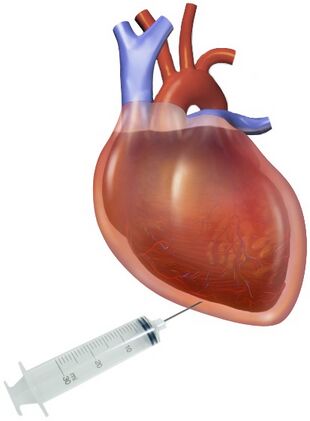Medicine:Pericardiocentesis
| Pericardiocentesis | |
|---|---|
 | |
| ICD-9-CM | 37.0 |
| MeSH | D020519 |
| MedlinePlus | 003872 |
Pericardiocentesis (PCC), also called pericardial tap, is a medical procedure where fluid is aspirated from the pericardium (the sac enveloping the heart).
Uses
Cardiac tamponade
Pericardiocentesis can be used to diagnose and treat cardiac tamponade.[1][2] Cardiac tamponade is a medical emergency in which excessive accumulation of fluid within the pericardium (pericardial effusion) creates increased pressure.[3] This prevents the heart from filling normally with blood. This can critically decrease the amount of blood that is pumped from the heart, causing obstructive shock, which can be lethal. The removal of the excess fluid reverses this dangerous process, and is often the first treatment for cardiac tamponade due to its speed.[3]
Analysis of pericardial fluid
It can also be used to analyze the fluid surrounding the heart.[1][2] Fluid may be analysed to differentiate a number of conditions, including:[citation needed]
- infection
- spread of cancer
- autoimmune conditions, such as lupus and rheumatoid arthritis
Pericarditis
Pericardiocentesis can relieve the symptoms of pericarditis.[1][2] There may be a normal amount of pericardial fluid, but inflammation still causes compression of the heart. Removal of some of this fluid reduces pressure on the heart.[citation needed]
Contra-indications
Long-term drainage
Pericardiocentesis is a one-off procedure, which may not be appropriate for long-term drainage. In cases where longer term drainage is needed, the cardiothoracic surgeon can create a pericardial window. This involves the removal of a section of the pericardium, and the placement of a chest tube.[citation needed]
Aortic dissection
Pericardiocentesis is not appropriate if cardiac tamponade is associated with aortic dissection.[2] In this case, there is a high risk of the procedure worsening this aortic dissection by causing haemorrhage.[2]
Diagnosis of pericardial effusion
Pericardiocentesis is not usually useful for diagnosis of more minor pericardial effusion.[1][2]
Risks
Fewer than 1.5% of patients experience complications from pericardiocentesis.[4] The most common complications are lacerations of coronary arteries, and puncture of the left ventricle (with associated bleeding from both).[4][5] Echocardiograms can help to identify complications.[5] Blind approaches are typically only advised in emergencies, and a guided approach is typically preferred (using echocardiography).[5][6]
Technique
Position
The patient undergoing pericardiocentesis is positioned supine with the head of the bed raised between a 30 and 60 degree angle. This places the heart in proximity to the chest wall for easier insertion of the needle into the pericardial sac. Anatomically, the procedure is carried out under the xiphoid process, up and leftwards.[3][7]
Process
Pericardiocentesis is usually performed using a local anaesthetic.[6] A wide-bore catheter is inserted.[6] More modern procedures may be performed in a cardiac catheterization lab.[3][6]
There are two locations that pericardiocentesis can be performed without puncturing the lungs.[8]
- The most standard location is through the infrasternal angle and is also called subxiphoid approach.[3][8] The needle is inserted at an angle between 30 and 45 degrees to the chest.[9]
- Another location is through the 5th or 6th intercostal space at the left sternal border at the cardiac notch of the left lung, and is also called as parasternal approach.[9] The needle is inserted at an angle of 90 degrees to the chest.[9] Some evidence suggests that this poses lower risk of vascular damage in adults.[9]
Intraoperative assessment
Pericardiocentesis is generally done under ultrasound guidance to minimize complications.[6] An electrocardiogram (ECG) is continuously recorded during pericardiocentesis to assess for complications.[3]
References
- ↑ 1.0 1.1 1.2 1.3 Gupta, Pooja; Ibrahim, Amar; Butany, Jagdish (2014-01-01), Willis, Monte S.; Homeister, Jonathon W.; Stone, James R., eds., "Chapter 16 - The Pericardium and its Diseases" (in en), Cellular and Molecular Pathobiology of Cardiovascular Disease (San Diego: Academic Press): pp. 297–314, doi:10.1016/b978-0-12-405206-2.00016-8, ISBN 978-0-12-405206-2, http://www.sciencedirect.com/science/article/pii/B9780124052062000168, retrieved 2020-12-03
- ↑ 2.0 2.1 2.2 2.3 2.4 2.5 Jneid, Hani; Maree, Andrew O.; Palacios, Igor F. (2008-01-01), Parrillo, Joseph E.; Dellinger, R. Phillip, eds., "Chapter 6 - Pericardial Tamponade: Clinical Presentation, Diagnosis, and Catheter-Based Therapies" (in en), Critical Care Medicine (Third Edition) (Philadelphia: Mosby): pp. 85–92, doi:10.1016/b978-032304841-5.50008-x, ISBN 978-0-323-04841-5, http://www.sciencedirect.com/science/article/pii/B978032304841550008X, retrieved 2020-12-03
- ↑ 3.0 3.1 3.2 3.3 3.4 3.5 Fashoyin-Aje, Lola A.; Brahmer, Julie R. (2020-01-01), Niederhuber, John E.; Armitage, James O.; Kastan, Michael B. et al., eds., "59 - Malignancy-Related Effusions" (in en), Abeloff's Clinical Oncology (Sixth Edition) (Philadelphia: Elsevier): pp. 863–873.e4, doi:10.1016/b978-0-323-47674-4.00059-1, ISBN 978-0-323-47674-4, http://www.sciencedirect.com/science/article/pii/B9780323476744000591, retrieved 2020-12-03
- ↑ 4.0 4.1 Sorajja, Paul (2018-01-01), Kern, Morton J.; Sorajja, Paul; Lim, Michael J., eds., "17 - Pericardiocentesis" (in en), The Interventional Cardiac Catheterization Handbook (Fourth Edition) (Elsevier): pp. 438–447, doi:10.1016/b978-0-323-47671-3.00017-x, ISBN 978-0-323-47671-3, http://www.sciencedirect.com/science/article/pii/B978032347671300017X, retrieved 2020-11-16
- ↑ 5.0 5.1 5.2 Sovari, Ali S. (2019-01-01), Brown, David L., ed., "44 - Pericardiocentesis" (in en), Cardiac Intensive Care (Third Edition) (Philadelphia: Elsevier): pp. 461–464.e1, doi:10.1016/b978-0-323-52993-8.00044-8, ISBN 978-0-323-52993-8, http://www.sciencedirect.com/science/article/pii/B9780323529938000448, retrieved 2020-11-16
- ↑ 6.0 6.1 6.2 6.3 6.4 Balmanoukian, Ani; Brahmer, Julie R. (2011-01-01), Davis, Mellar P.; Feyer, Petra Ch.; Ortner, Petra et al., eds., "32 - Pleural and pericardial effusions" (in en), Supportive Oncology (Saint Louis: W.B. Saunders): pp. 354–361, doi:10.1016/b978-1-4377-1015-1.00032-1, ISBN 978-1-4377-1015-1, http://www.sciencedirect.com/science/article/pii/B9781437710151000321, retrieved 2020-12-03
- ↑ Sam, Amir H.; James T.H. Teo (2010). Rapid Medicine. Wiley-Blackwell. ISBN 978-1-4051-8323-9.
- ↑ 8.0 8.1 "Pericardiocentesis". http://www.sonoguide.com/pericardiocentesis.html.
- ↑ 9.0 9.1 9.2 9.3 Steele, Robert; Thorp, Andrea (2008-01-01), Baren, Jill M.; Rothrock, Steven G.; Brennan, John A. et al., eds., "Chapter 180 - Pericardiocentesis" (in en), Pediatric Emergency Medicine (Philadelphia: W.B. Saunders): pp. 1259–1262, ISBN 978-1-4160-0087-7, http://www.sciencedirect.com/science/article/pii/B9781416000877501835, retrieved 2020-11-16
External links
- MedlinePlus Encyclopedia 003872
- med/3560 at eMedicine
- Trauma Man: Images of pericardiocentesis being performed on a simulator
- Cardiac Surgery in the Adult: Pericardial disease
